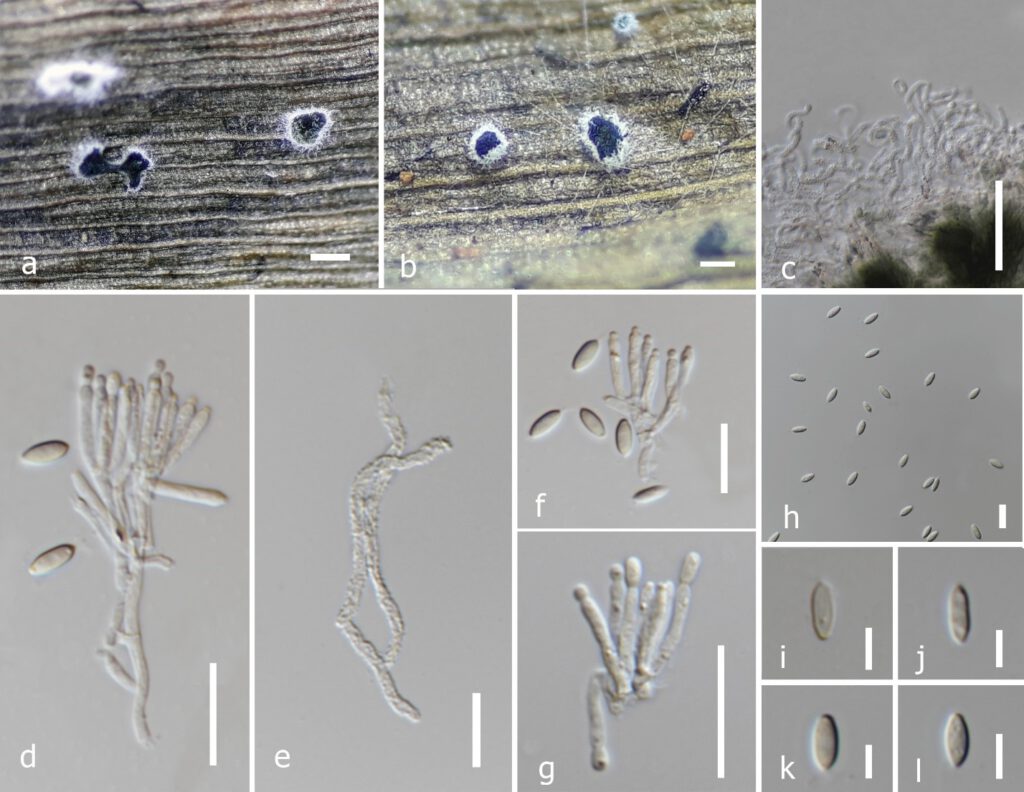Albifimbria verrucaria (Alb. & Schwein.) L. Lombard & Crous, in Lombard, Houbraken, Decock, Samson, Meijer, Réblová, Groenewald & Crous, Persoonia 36: 177 (2016) Figure 03
MycoBank number: MB 815927; Index Fungorum number: IF 815927; Facesoffungi number: FoF 04192;
Saprobic on dead leaves of Musa sp. Sexual morph: Undetermined. Asexual morph: Sporodochia cupulate or discoid, scattered or gregarious, having irregular or rounded outline composed of white marginal hypha, with conidial mass flattened or convex, pale olivaceous green at immature stage, black and shiny at maturity, 10–18×0.8–3μm (x̄=12.3×2.4μm, n=20). Stroma rarely well-developed, usually with a thin layer of isodiametric or elongate hyaline cells 15–25 (x̄=16.8μm, n=10). Setae: not observed. Marginal hyphae hyaline, usually verrucose, septate, curling and coiling, some branched, rounded or blunt at apex, 1.5–3.8 (x̄=3.3, n=20) in diam. Conidiophores arising from thin stromatic layer, hyaline, smooth, 30–48×1–2μm (x̄=42.2 ×1.7μm, n=30) septate, branching repeatedly, forming 2–4 branches at each level, with ultimate branches becoming phialides, which give rise to numerous conidia, conidiophores sometimes also arising from the hyphae. Phialides hyaline, rough-walled 30–48×1–2μm (x̄=42.2×1.7μm, n=30), 3–7 in a whorl, closely packed in a dense parallel layer, cylindrical, hyaline, collate at base, rounded or acute at apex, sometimes slightly tapering towards apex, 8–16×1–3.5μm (x̄=12.2×1.8μm, n=30). Conidia broadly fusiform, always pointed at one end, mostly truncate or rounded at the other end, hyaline, sometimes sub hyaline, smooth, 5–9.5×2–3.5μm (x̄=7.6×3.0μm, n=30).
Culture characteristics: Conidia germinating on PDA after 12 hours. Colonies growing on PDA reaching 40 mm diam. after 2 weeks in the light conditions at 25 °C, mycelium mostly immersed, not slimy, cottony, white, dense in the middle and comparatively sparse at the periphery, fast growing. Sporodochia formed after 12 days at the center as a black uneven ring.
Material examined–THAILAND, Chiang Rai Province, Mae sai, on dead leaf of Musa sp., 25 June 2019, Binu Samarakoon, BNS292 (MFLUXXXX), living culture MFLUCC XXXX
Notes: Based on BLASTn search results of ITS, tub2, rpb2 sequence data, our stain (MFLUCC XXXX) showed a high similarity (ITS=100% tub2=100% and rpb2=99%) to Albifimbria verrucaria (CBS 188.46). In the multigene phylogeny, MFLUCC XXXX grouped with A. verrucaria strains with a strong statistical support (97% ML, 1.00 BYPP) (FIGURE 1). Morphologically, our collection is similar to the descriptions of Tulloch (1972) and Lombard et al. (2016). Albifimbria verrucaria has previously been reported from Musa sp. as a saprobe in Venezuela (Dennis, 1970). This is the first report of Albifimbria from Thailand. MFLUCC XXXX is the first saprobic A. verrucaria strain found in Thailand. In addition, this is the second report of Albifimbria on Musaceae.

FIGURE 3. Albifimbria verrucaria (MFLU XXXXX) a, b Sporodochia on the host c, e Marginal hyphae d, f, g Conidiophores and phialides h-l Conidia. Scale bars: a, b=400μm, i-j= 100 μm c =50μm, d-h=10μm, i-l=5μm.
